Ringworld: Roleplaying Adventure Beneath the Great Arch by Nessus
Well, I found it.
Original SA postWell, I found it.
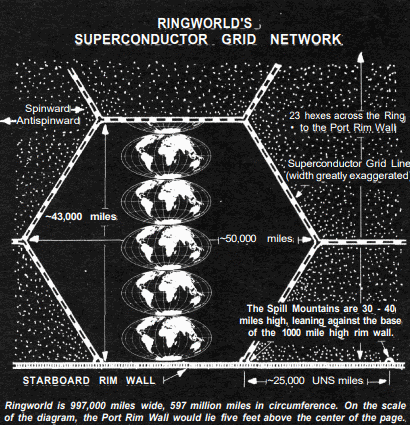
All of it.
The Ringworld RPG was published by Chaosium in 1984. It uses a version of the Basic Roleplaying rules which are most famous from Call of Cthulhu in the present day, and uses Larry Niven's "Known Space" works as a setting, up to and including, of course, Ringworld itself. The setting is meant to explore the titular Big Dumb Object, and many of the books are more of an elaborated story bible derived from the Known Space stories than what we'd call actionable material. (Nonetheless it comes in at about three hundred pages. That's half the Exalted 3E core!)
The set was split into four books. The Explorer Book is a standard Player's Handbook and includes information on Known Space and how to roll up a PC, including rules for playing one of the two alien races represented in the original novel (the Kzinti and my own august people.) The Technology Book discusses widgets and wadgets in exacting detail. The Creatures Book discusses aliens, the many humanoids of the Ringworld, and sundry monsters. Finally, the Gamemaster's Book discusses the obvious GMing stuff, provides a giant bucket of secret setting lore/extrapolations, a somewhat smaller but still juicy list of hooks to build schemes around, and a relatively complex introductory campaign, adventure, I'm not sure what to call it.
There is, in addition, a companion book with a whole bunch of elaboration and other material, another campaign featuring at least one of the canonical Ringworld characters, and - somewhere; I don't have it - a writeup in a Dragon issue for playable Dolphins.
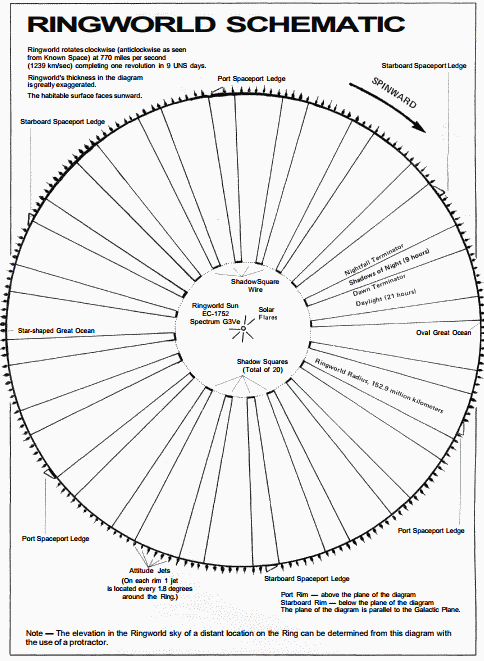
habitable surface faces in
Since a great deal of this material is interesting to read, but not interesting to read about, I will be giving selected highlights and summaries for lengthy parts of background information.
Several caveats before I proceed.
First is that this is all going to be spoilery as hell for the Known Space books, which are not exactly great literature but may be enjoyable if you're fond of "old school" science fiction.
Second is some content guidance: biological/ecological motivations come up pretty often when discussing the broad patterns of behavior in this particular setting. Niven avoided what we would probably consider  when describing members of Homo sapiens, and in several areas the game's authors create space where Niven closed things off for the sake of a story vs. a game setting. However, it DOES come up for a fair number of aliens. There is also some incidental cannibalism, mass manipulation of populations, and sex outside of one's own species, but that's just the good clean fun of a Role-Playing Scenario.
when describing members of Homo sapiens, and in several areas the game's authors create space where Niven closed things off for the sake of a story vs. a game setting. However, it DOES come up for a fair number of aliens. There is also some incidental cannibalism, mass manipulation of populations, and sex outside of one's own species, but that's just the good clean fun of a Role-Playing Scenario.
If there are any broad topics that interest the audience, sing out; I will prepare an exploration of the player's guide in the near future.
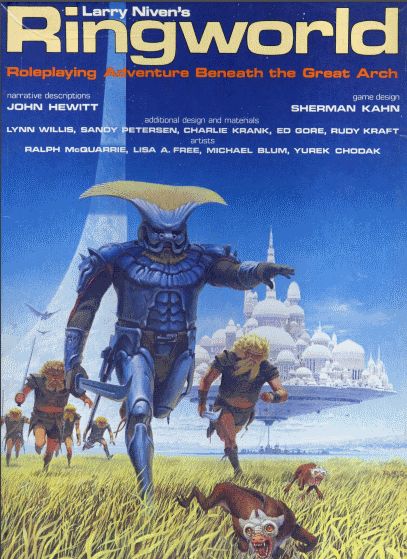
I'm the excited creature on center bottom!
if you liked it then you should've put a
Original SA post if you liked it then you should've put a
The introduction leads off by noting exactly which Niven books this game draws from, and a general note that this is an RPG, so don't expect it to be canon-perfect, especially in your own games. The core premise is also brought up: That you are all people on an exploration mission to the Ringworld, hailing from Known Space, who have hied yourself off to seek the people's ovation and fame forever by doing... something. Even if you are literally there to rob the place blind, you will, by necessity, be functioning as explorers.
There is also the introduction to the concept of a roleplaying game, which is remarkably concise and advanced for the time - or indeed, for today.
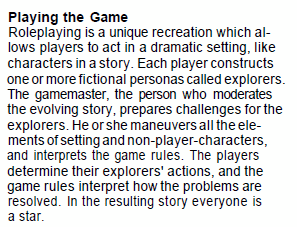
After a brief introduction to the concept of how to use dice - including instructions on how to doctor a D20 to serve as a D10, because the box set included the former instead of the latter - we go on to EXPLORER CREATION. ('Explorer' is the books' synonym for 'PC' and I will probably slop between them.)
After a summary of the setting and a note that the GM has the right to veto non-human explorers, the outlines are brought up. The reason for the possibility of playing a 400-year-old is that in Known Space, a more or less perfect human anagathic was developed a bit under 400 years ago. The option of random rolling is provided, but it is also suggested that you might jot down the skills you want and use these figures to work backwards. ("In using this method, refrain from granting any skill higher than 100%.")
Character creation goes like this.
Pick gender, consider if you came from "a community in which men (or women) dominate," no statistical difference.
Pick home world, which has an impact on some stats, and is culturally important. You can also be from some backwater or a bubble world or whatever. This is meant to reflect where your character grew up, not just their cultural identity.

If your homeworld is light gravity, -3 to STR and MAS, +3 to DEX. If it's heavy gravity, you Jinxian son of a bitch, +3 to STR and MAS, -3 to CON.
Defects! Do you have one? Most of them have been handled already due to advanced medical science and widespread organ transplants. (About which more later.)
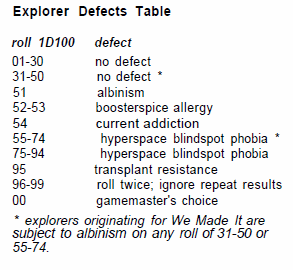
if you're curious about any of these, ask!
Chronological age! And also Physiological Age! These are distinct because your character may be hopped up on boosterspice. If you had boosterspice allergy, sucks to be you - physioage must match chronological age.
Characteristics! Or as some might call them, "scores" reflecting one's "abilities." There are eight, and it's pretty much the Call of Cthulhu spread. All are determined by 2D6+6 except EDU, about which more in a minute. These are:
* Strength: Swole factor. Affects melee damage and deadlift.
* Mass: SIZ by any other name: it represents the total volume of your character's body, which informs weight and damage modifier.
* Constitution: How fit are you? (The fictional reason for a CON hit to heavy gravity is cardiological strain.)
* Intelligence: Intelligence.
* Power...
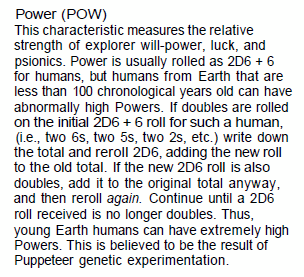
Slander! Base slander and calumny.
* Dexterity: Flexibility, adroitness, and ability to act more than the other guy and win fights.
* Appearance: Largely Charisma, but not explicitly.
* Education: How much schoolin' you've gotten, with each point approximately representing one year. You start with 10, roll a D6 and add that, and if you roll 5 or 6, add that and keep on rolling.
Since this is BRP, we have some derived stats. Damage modifier affects your melee damage and is derived from STR+MAS; general hit points are CON+MAS; the health roll, which represents not getting dysentery and gangrene so easy, is CONx3; reasoning roll, INTx3; Luck roll, POWx3; Dodge roll, DEXx3. There's also hit locations, unfortunately, as well as an "action ranking" (high dex = go faster), a basic land speed of 3 meters, and the allure of a "Psionics" section, left undefined.
Next up is tossing points into skills through PURSUITS. The concept here is that your character, who may be an old woman or whatever, has learned things through training, often a lot of things. You can spend some points from your EDU to buy more academic skills, but then you consider pursuits, which can give you money but also help flesh out a character's life story. This is largely inspired by the viewpoint character Louis Wu, who is a 200-odd year old human who has gone through a range of different professions.
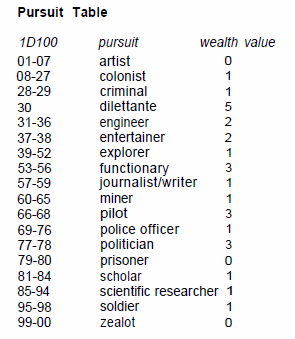
UN secgen elections tainted by fake news from gummidgian troll farms. sad
Oh, it also affects how rich you are.
Most of these boil down to "If you were a researcher, buy up sciences; if you were an artist, buy up expression". You should also note number of years your character did things in if you want to roll up for your Wealth, but after this and some beginning items (mostly tchotchkes), it is supposed to be probably-meaningless, as the game is intended to let you adventure on the Ringworld, where your funny money from "We Made It" is useless anyway. However, these rules would also be entirely usable for scenarios in Known Space, and the rules do expect that the characters will probably go back and forth for reasons other than "the campaign ended and we didn't die."
Then we get to how skills work. Basically: percentile dice; roll low. A "special success" comes from rolling under 20% of your skill - if you have Frombotzing 60%, you get a special success on a 12 or lower. A "special failure" is poorly explained, but seems to be "one-twentieth of your skill" - so our Frombotzer would "special failure" on a 96-100.
A roll of 96 or higher always fails, except at very high skill levels: at 601% you only fail on 97 or up, at 701% at 98 or up, and at 1000% only a 00 fails. A 00 is considered to always be a special failure, no matter what.
There's a bunch of skills, most of them boring. There are a few setting limits to represent imprecise cultural knowledge of aliens, and some notes in the skills that some of them should not be taken without a clear reason - for instance, Louis Wu, the 200 year old man, didn't clearly know what an axe was. He'd never encountered one, or at least, not in a context where he associated it with reality.
Finally, experience. You can train from teaching, studying, or various futuristic forms of brain-stuffing which are available in the setting. To get a skill past 100%, you have to actually go learn in the field, or at least do something, Jesus. Get off your ass, flatlander.
NEXT TIME ON RINGWORLD: An exciting precursor of Chuubo-style storypaths in the form of planning research projects, and also: Violence.
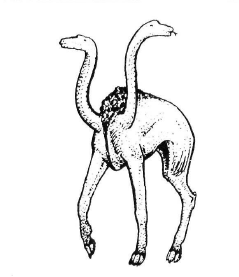
your correspondent, shown unflatteringly
bound - with love's desire. i stepped into a
Original SA post bound - with love's desire. i stepped into a
The research system is presented, a little confusingly, in the skill development section. See, it's possible to learn from experience as well as tutoring and various forms of future brain training, but formally researching a topic can unveil a secret of the Ringworld. This is presented as a collaborative process, where the player approaches the GM and says, "I want to have my guy figure out what the Ringworld's foundation material, scrith, is made out of." (This is an example. You don't have to learn what scrith is if you don't want to.)
The GM assesses his own plans and schemes, what the player has on their sheet, so on and so forth, and then builds out a few steps towards a particular goal, a lot of which requires things like "spend 200 hours doing a literature review," and others of which involve "capture a live Muck Ogre, and then observe it in captivity for a while, then dissect it." These involve a range of skill rolls and sometimes a specific play session - for instance, having to play Monster Hunter to get a Muck Ogre.
The system as presented is very fiddly, with a lot of things like "you need THIS many hours of off-screen busywork," but for 1984 I think this is pretty forward-looking. It really does remind me of nothing more than the systems in Chuubo.
There's also a side note about adjusting your
EDU: go to school
APP: Get glam (significant financial costs) for APP+1 or +2, which may fade if you can't get new supplies of makeup or similar.
STR, CON, MAS: Any of these can be increased up to matching the highest value of them. I.e. if you have MAS 13, STR 10, CON 9, you can in principle work hard and beef up to STR 13 and CON 13. During chargen, you can also either buy more MAS at the cost of 1 CON per added MAS and 1 STR for every third point of more MAS, which is meant to represent being a lardass. (You can, presumably, game the system this way. I assume that's how Fat Buu got so strong.) You can also lower MAS to match your STR; if your STR is higher than MAS, tough titty, you're already swole.
INT, POW, DEX: Cannot be permanently increased save by becoming a Protector.
There's also a Resistance Table, because of course there is.
We touch on time intervals. Trivia fact: The UN standard day is 24 hours long (presumably leap time is considered a minor quirk of Earth's), while the Ringworld day is 30 hours long (21 daylight, 7.5 night, balance dawn/dusk). The rules recommend treating the two as interchangeable for purposes of schemes and things that count "days."
Now we have the Action Sequence, which involves IMPULSES. Basically, the idea is that you track events by these specific one-second "Impulses," which are a kind of discrete unit to cover the time in which all things happen. A live healthy human can move 3 meters in one impulse, or 6 meters if they're sprinting. Minor actions, such as firing a ranged weapon, take one impulse; major actions, such as melee attacks, take a number of impulses determined by your DEX.
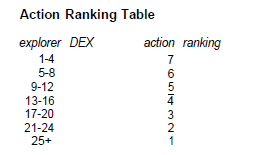
If I understand this correctly, let's compare two hypothetical people.
Julian Forward has 10 DEX, vs. Beowulf Schaefer, who has the theoretical starting max DEX of 21. (That's 18 for the roll, +3 for being from We Made It.) In the time it takes Julian to throw one punch, Beowulf can throw a counterstrike (if he wants) and move backwards three impulses, or 9 meters. Julian would, rules as written, keep up pace in a footrace, but in any kind of a conflict situation, Beowulf has a massive advantage, especially as you can combine moving 3 meters with a minor action.
Combat is pretty standard; roll your weapon skills with various modifiers. There are hit location tables. Dodging takes an impulse, and you can't do anything else unless your skill in "anything else" is over 100%.
There is a note that you shouldn't overcomplicate your actions, but this was 1984 so I assume this is more to deal with wargamers trying to make complex nested conditionals, when the idea is you say "I run to Julian and shoot at the Kzin" or "I aim at the whatever the fuck that is" and then move on, rather than narrating a Platinum Games cutscenes.
Damage sucks. Don't get hit. It's similar to Call of Cthulhu, balanced mostly by the Godlike power of the autodocs, which can sew you back together if you arrive with conventional trauma injuries.
Natural hazards suck. Don't fall into radioactive waste or stick your reproductive organs in a hard vacuum. Don't inject poison into your eyeballs.
That's about it. Next up, step up for the grand tour (grand tour) (grand tour) - this one was kind of shitty other than the weird impulses system, but coming up next is the history of Earth and other worlds between c.1980 e.v. to the 29th century, when the Ringworld is found! I will probably get right on that.
History of the World: Part 1
Original SA post History of the World: Part 1
The timeline of Known Space diverges from Earth as we know it sometime in the 80s. (Naturally, we're looking back 33 years on upon these projections.)
The 21st century was marked by the development of zero-gravity industries and the first stages of space mining, which led to the Belter culture/civilization. (Fusion power was also perfected in the early 21st century - here's hoping! - which makes all the rest of this stuff hang together, from a certain point of view.)
Attempts to colonize Mars failed, but the Belt thrived, not least from finding magnetic monopoles, which were extremely valuable. Earth proper gradually became more and more unified and cooperative over larger and larger scales, with a general upward trend that had a range of disasters. A world police/military, the ARM (Amalgamation of Regional Militia, or perhaps Acronym Retroactively Made), developed, and did a lot of technology cop work, keeping the "Superman Insurrection" of a bunch of biotech companies down.
Earth's population stabilized at about 18 billion, with widespread "Fertility Board" authorization becoming generally accepted. Contraception was mandatory, and most people only got the right to have one kid apiece (so two per couple) which could be revoked if you had a bad genetic disease, or upped if you had super-desirable genes as well as some other obscure routes.
Society was wracked by the ease of organ transplants, which became a primary course of medical intervention, not least because of medical science making transplants more and more easy. Organleggers, who illegally broke people down for parts, were a major target of the ARM. Society in general got real happy with the death penalty for a while - execution was by being broken down for parts. This problem was eventually abated by development in artificial organs, cloning, and the development of Boosterspice, but cultural memories are long.
Interstellar colonies were founded by, first, sending out Bussard ramscoop robots to explore nearby stars, and then by sending out starships full of frozen aspiring colonists. The ramrobots had some programming errors, most notably that they sought Earthlike conditions but not a generally Earthlike planet, leading to anomalies like Jinx (two habitable bands on a moon that has a gravity of 1.78G) and Plateau (earthlike conditions on a large plateau jutting well above the rest of the atmosphere, which was dense and poisonous). Having no way to return home, the settlers made the best of it.
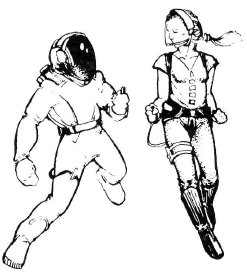
hey babe, come to the thread often?
i have a tasp
i'm into that
Humanity also ran into aliens.
The first were Dolphins, who of course are our neighbors, and who had become citizens of Earth and UN members through the 21st century.
The second was Kzanol, a survivor of the "Slavers," a species of powerful telepaths who had dominated the galaxy billions of years ago. Kzanol was in a stasis field, and he was eventually returned to it, but Slaver technology became a big thing - not least because it was possible to find some Slaver relics in similar stasis fields here and there.
Third were the "Bandersnatchi," who had been food animals raised by the Slavers. Handless but intelligent, they survived on Jinx, and the Jinx Institute of Knowledge was founded to figure out how to talk to them. (In addition to being very durable, Bandersnatchi were essentially titanic single cell organisms with chromosomes the size of sausages - so they didn't mutate.)
Fourth was a so-called "Pak protector," a hominid from the direction of the Sagittarius constellation who had came to "save us" from something or other. This creature exposed Jack Brennan, a Belt miner, to some chemical agent, mutating Brennan severely. Brennan summarized a threat from the "Pak," a warlike species who we should keep an eye out for, because they'd wipe out humans for being dangerous mutants. He then vanished. Earth learned how to make gravity manipulation technology from the Pak ship, though.
Fifth were the Kzin, who conquered the colony world Wunderland and were held at bay by Belter laser systems and the power of reaction-drive ships used as weapons for a while. (This also represented a conclusion of a 250-year era of peace, which is no small thing. Imagine if Earth had been war-free since 1777!) The Kzin were powerful warriors loosely resembling humanoid, man-eating tigers. We Made It bought the hyperdrive from the Outsiders and hyperdrive-equipped human ships were able to win the war - the Kzinti had no hyperdrive.
The Man-Kzin wars did not go well for the Kzinti, with the score something like this:
First War: Eventual human victory and liberation of Wunderland; seizure of a Kzinti world, named "Down"
Second War: Human victory after fending off a surprise attack; liberation of the Kdatylno
Third War: Human victory; liberation of Canyon and the Pierin home system
Fourth War: Human victory; armed landing in the personal estates of the Patriarch of Kzin
The impact on the Kzinti will be discussed when we get to them, but there was a religious movement among them that theorized that God had created humanity - NOT the Kzinti - in His image. They would pray while wearing human-skin masks in the hopes of fooling God long enough to win a war.
The Puppeteers also showed up, founding a trading empire and then ditching it several hundred years later because they found out the galactic core was exploding and in a mere few tens of thousands of years, a massive radiation wave would reach Known Space! Probably.
The human parts of Known Space are in a loose cooperative state with an Interworld Council wrangling details and handling interplanetary disputes. Earth is the big horse at the trough, but Jinx and We Made It are distinctly independent, with the smaller colonies tending to lean towards Earth. Earth's UN supports a "Federation of Human Worlds," but the proposal has not yet borne fruit.
Up next: Earth, Belt, Canyon, and maybe another planet or two!
welcome to earf *poonch*
Original SA post welcome to earf *poonch*
Now we visit the planets from which your human explorer can hail!
First of all,
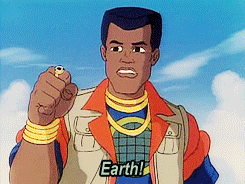
Earth is ruled by the United Nations, who presumably have fully instituted the New World Order and fed Alex Jones to the Kzinti. Agreements with the Belt (about which more shortly) give the UN ownership of Earth, the Moon, Titan, Mars and its Moons, and rights in Saturn's rings and mining on Mercury. The UN is also gradually terraforming Venus, which has gotten less nasty to the point where there are a few hundreds of thousands of settlers. (I assume they have umbrellas.) The Moon is the only one of these with a significant semi-autonomous population. There are about 1.1 million people in habitrails on Mars, which is also not being terraformed in deference to the probable native ecosphere. (There WERE martians - who killed some of the earlier colonists - but Jack Brennan dropped a water asteroid on Mars, and the resulting water enrichment of the planet killed them. Jack Brennan, of course, was insane and mutated.)
Jupiter and Uranus, along with their moons, are shared between Earth and Belt, with an Outsider base on Nereid and a Trinoc embassy over on Titan. There are also a few gas giant type planets past the orbit of Pluto, which are mostly remarkable for being outside the range of Earth's "hyperdrive singularity," which is basically "hyperdrive doesn't work too close to a star; something happens, and you die."
Earthicans are usually called "flatlanders" by the natives of colony worlds, who see them as pampered babies who live in a planetary environment that cossets them. Nevertheless, off-worlders enjoy visiting Earth. It feels right, somehow. (It's like your ancestors lived there.)
Earth's population of 18 billion live in crowded but well-kept cities which have a growing homogenety throughout the world due to cheap "transfer booth" international teleportation. There are still wide wild tracts in Australia, Canada, Africa, Siberia and the Amazon basins. The oceans are in pretty good shape and largely under Dolphin management, although bubblecities underwater are common.
So much for Earth. On to

the Belt!
After a guide through the rise of the Belter culture group (summary: Earth thought asteroid mining was dumb; turns out, they were wrong, and it's real hard to boss meteor miners, see also: Gundam), we get to the meat and potatoes, which is basically that they are a space-based human civilization that largely shares the Solar system with Earth and the United Nations. There's a cool list of unique and specific developed asteroids for people to encounter or be from. Belters are, in general, rugged frontier types, or at least, were, and are now still pretending they are. Fortunately, they're all in space, so they can't hurt anybody but themselves. Belters also opted not to go execution-happy to get organ supply back when that was a thing, and they consider this a sign of their cultural superiority.
Canyon, which does not get a joke gif
Canyon is a borderworld which was marginally habitable until a massive weapon, used as part of the Third Man-Kzin War, ripped a hole big enough that, once it cooled down, atmospheric pressure was breathable inside of it. It is close enough to Kzinti space that the bottom of the titular canyon has been kzin-scaped, not earth-scaped, and they get a tourist trade from both species. Population is about eight and a half million.
Down
Down is a tidally locked but habitable world with a large moon, around a red dwarf star. The moon's tidal friction helps keep the planet generally habitable. It was seized because the Kzinti were using it as a naval base; it was conquered largely by forces from We Made It, who had also liberated Wunderland. It's very reddish and has a lot of Australian and Asian human settlers.
There are also the Grogs, sessile organisms with powerful mental abilities. They hid from the Kzinti and only reached out to humans because humans had built prosthetic limbs and such for Dolphins and Bandersnatchi. Locals are friendly with Grogs; the UN is taking no chances and has kept an emergency "induce a solar flare" equipment set near Down's sun, just in case the Grogs try to mind control everyone.
There's a neat sidebar here which I will incorporate at some point which is basically "here's like, five paragraphs on cool places to be a low-life in Known Space."
Gummidgy
Jungle planet. It is described eloquently, but that's the long and the short of it.
Home
Home was an Earthlike planet which had not developed much land-based life, though there was a thriving marine ecosystem. Unfortunately, when it had a population of a little under four million, some kind of mysterious plague happened here and killed literally everyone. How horrible! The planet was resettled a few centuries later, recently enough to kind of retain a "frontier character." Shame about that plague though. I wonder what happened there, JACK BRENNAN.
Jinx
The most autonomous and perhaps most powerful non-Earth planet in human space, Jinx is a high-gravity world (1.78g) with two "temperate" zones suitable for human habitation, a super-dense "equator" zone whose ocean often edges around 200 degrees F, and "ends" that protrude into a near-vacuum state. The planet (actually a moon, really) looks like an egg - it's that stretched out.
Nevertheless. Jinx has two billion inhabitants, enough economic strength that everyone (except maybe Earth internally - it's not clear) denominates their money in Jinxian "Stars," and hosts the top university of Known Space, the Institute of Knowledge. The main downside in being from Jinx is that you end up looking like Mark Henry and even boosterspice doesn't help you as much as it should.
Margrave
Yukon Planet. The planet is named after a psionic engineer who discovered it, crashed, awaited rescue, and eventually died. The natives all want wide open spaces and cold weather, and it is noted that they may even be carrying firearms. There is some implication that Margrave had a Moon like Earth or Home, but that it was destroyed, perhaps as recently as a few hundred thousands of years ago...
Plateau
Plateau is centered on a - well - plateau that juts out of a too-dense atmosphere (for humans) into one that's just about right, as well as being breathable. This vast plateau, also known as "Mt. Lookithat," has habitable space comparable to that of California or Japan, and hosts about 100 million humans. They have taken pains to be mostly self-sufficient, and apparently produce a lot of sports stars.
Plateau was notable in the past for a brutal caste system, where the descendants of the crew of the ramships that brought colonists to the planet thawed out colonists one at a time and essentially informed them that they could either agree to be second class citizens, OR get to find an exciting new career as an organ donor. This state of affairs continued for hundreds of years and finally the "Covenant of Planetfall" was nullified, in no small part due to advances in medical science. The marks of this cultural rift remain.
Silvereyes
Hawaii Planet. The name comes from entire islands with runaway growth of Slaver sunflowers, essentially living solar concentration mirrors that can and will fry your ass if you try any shit. Local life is evolved to deal with the Slaver sunflowers. Population is about 170 million, not bad for Hawaii Planet.
We Made It
While habitable, this planet has immense and massive winds throughout much of the year. The initial colony ship also nearly crashed, DID crash on the planet's moon, and later staggered back down, hence the "crashlander" epithet. For complicated reasons, many of them were also considered undesirable under the UN's fertility board laws, so they had a chip on their collective shoulders.
They dug underground and used local resources well, including making use of the truly atrocious surface winds.
Now, We Made It is... dare I say it... California Planet, who are thought to be indolent anarchists if creative and intelligent. They are specifically said to be good explorers.
An example of good mythmaking comes from an aphorism in the planetary capital's park:
When first we arrived, there was nothing but sand and sea, wind and sky;
Know that all you behold is here because
We Made It
Wunderland
A bucolic fairytale land where everyone had wonderful rural estates slightly tinged with a Germanic overtone of aristocracy and snobbery. They were conquered by the Kzin, who ate a lot of people. We Made It bailed them out.
Wunderlanders are often fat and portly if not of refined, elven-ass aristocratic birth. They even have wiggly ears. Wunderland is apparently free-wheeling and legally flexible, and they have a recurring aesthetic fascination with asymmetry.
Well, that's that. I'll spare you editorializing about what these planets suggest, and I can answer any more specific questions folks may have, but next time we'll get to what the people want, what the people demand:
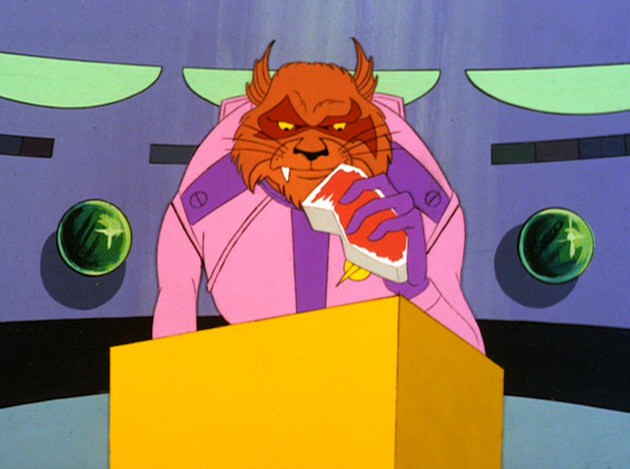
Kzinti character rules.
10 scream 20 leap 30 goto 10 40 end
Original SA post 10 scream20 leap
30 goto 10
40 end

Today we meet the Kzin.
We've touched on the Man-Kzin wars. We're going to start this by skipping ahead a little to examine Kzin culture, lifestyle and society.
Kzinti are large (2.4 meters average) catlike creatures which resemble humanoid predator cats, primarily tigers. The resemblance isn't perfect; their ears resemble those little paper umbrellas you find in your drink, their pupils are round like humans', and their tails are more like rats than cats, anatomically. But that's the general idea. From a distance they resemble big fat tabby cats. A safe distance.
Kzinti place a great premium on honor, courage and honesty. Their general cultural perspective is that the Kzinti should, eventually, rule the galaxy. Their government is called, straight up, "the Patriarchy," and is essentially feudal, with new honors and total decadence prevented by the system of Names.
Kzinti have to do something really sweet and cool to earn a Name (the way this is done is not clear, but presumably it's done through the Patriarchy's bureaucracy). Conquering a planet, obtaining a new hyperdrive, saving the Patriarch's life, stuff like that. Kzinti of exalted birth or less exalted but still meritorous deeds would receive a partial name ("Chuft-Captain") while your everyday Kzin would be known by a professional name (Speaker to Animals, Slaverstudent, Telepath).
One of the benefits of a Name is that you get breeding rights. The "Patriarchy" label is not a euphemism. Kzinti females were, long ago, selected genetically to be docile and stupid, and are not treated legally as people by Kzin law and custom. (This is not neccessarily the case for ALL kzinerret. It is explicitly not the case for the Kzinti who were taken to the Ringworld - but we'll get there.) Earning a Name means you can keep a harem and get your Bone on. This produces kittens, who in time become Kzin, or do not, and instead die. This, along with the violence inherent in the system, keeps Kzin population numbers relatively low; Kzin itself has about 250 million (male) kzin on it, despite having less ocean than Earth. Lots of big hunting estates.
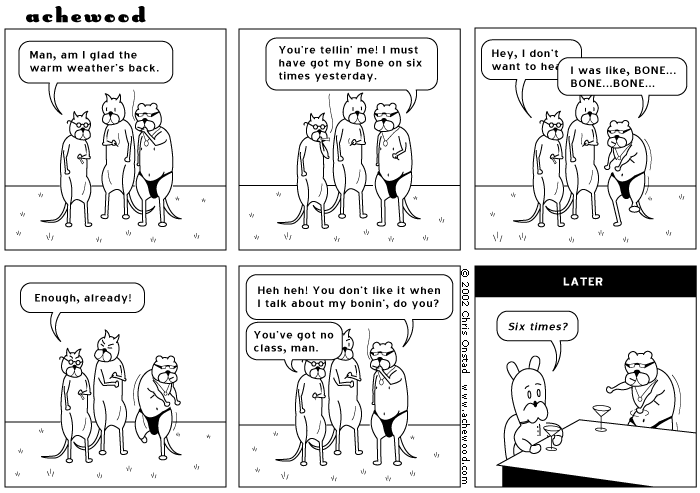
shown here: the daily activity of the typical Named kzinti
Kzinti are not particularly bigoted towards human women, despite living in a literal Patriarchy, and recognize that human women are intelligent beings, although they will not necessarily comprehend this at all times, or if not prompted. They are, in fact, decidedly intelligent-female-curious, although they do not seem to show sexual interest in the way that humans do.
The Kzinti have learned empathy and social behavior - or at least, the prospect of living with other species on a non-tyrannous basis - by the expedient of losing the great majority of their young during each Man-Kzin war, as they are heavily militarized and young Kzin are motivated to help out in conquests by the promise of Names and new slave worlds where they can be top cat.
Most of the species in Known Space had been enslaved by the Kzinti to at least some extent. This even includes humanity (the Wunderlanders). At present the Patriarchy is demilitarized except for police gear and ships; this is enforced by humans, after giving the Patriarchy repeated ass kickings, to the point that a fifth Man-Kzin War would probably lead to a human conquest of Kzin itself.
So much for the Kzin. Oh, one fun note: Kzinti telepaths. The only psionic ability that the Kzin usually show is telepathy, which is induced by a special drug and extends over two thousand kilometers, making them very useful on Kzin military vessels. They cannot, thank God, instill commands like a Grog.
Using the drug is an ordeal and most Telepaths are bedraggled neurotic wrecks due to its use and the experience. At present, Telepaths are pretty much always involved in crimes. They cannot be forced to read the minds of herbivorous entities (such as Puppeteers.)
We'll discuss Kzin character generation next time, including some of the few remaining planets that the Kzin didn't lose to human attack fleets!
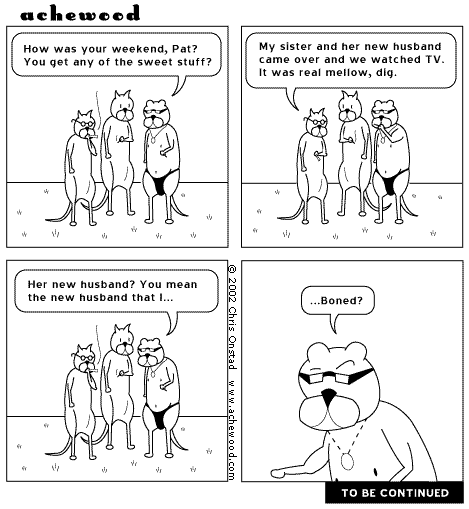
kzinti character generation will be conducted featuring ray smuckles.
Kdapt-preacher, forgive me, for I am Ray Smuckles.
Original SA post Kdapt-preacher, forgive me, for I am Ray Smuckles.
We'll be combining an abbreviated form of chargen with showing off the Kzinti rules, because I can make an extended joke that way.
A thumbnail sketch of our example character, so that we may adhere to things. Ray-Bandleader works as a manager of musicians throughout Kzin space, guiding their works and performances and arranging for intercourse with non-kzin interested parties. (His occupation-name is somewhat archaic; literally "Commander-of-musical-performers.") Ray earned his name contending in an organized fighting tournament for the pleasure of the Patriarch elite; his entry was because his father, Ramses, had earned his Name in a previous "Great Outdoor Fight". He only received a partial Name as his victory was shared with a battle comrade of his, and their methods of victory were thought to be "un-Kzinti," although others say that he and his brother-in-arms are the architect of the Great Outdoor Fight's future.
Ray is motivated to go to Ringworld because he has plateaued in life. He could challenge his father for his estates, but Ramses uses boosterspice and kicks ass for a living, so this is not really a viable route for ol' Ray.
First, names.
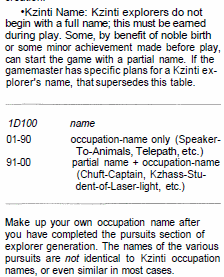
the naming of kzin is a difficult matter; it isn't just one of your holiday games
We established why Ray has a partial Name above.
Gender: All Known Space Kzinti explorers are male. A Ringworld-originated Kzin may be female, and does not suffer statistical penalties.
Homeworld: the Kzin haven't lost ALL of their planets. The table is short enough to describe here:
1-80: Kzin. Normal gravity.
81-87: First Conquest: A desert planet, the first one the Kzin conquered. The dominant lifeform were large quadripedal omnivores, possibly sentient, who the Kzin exterminated. "Our bad." Normal gravity.
88-90: Hurtling Rocks: Essentially, the Belt, but for Kzinti, but not in the Kzin system. No human has been permitted here, so there's a lot of rumors. Light gravity.
91-97: Water Conquered: A water-heavy planet, hotter than Kzin. Very rainy. Many ocean-based habitats, as well as prisons and work camps. Normal gravity.
98-00: Wind Carries Harsh Discipline: A small, dense, high-gravity planet with rich mineral deposits. Kzin here live in huge domed cities, the construction of which was the greatest non-military achievement of the Patriarchy. Same system as Hurtling Rocks; heavy gravity.
Kzin take the same light/heavy gravity penalties as humans, although they have less specific impact. Ray grew up on Kzin even if he has travelled extensively.
Education works differently for Kzin. All Kzin in the Patriarchy get some basic schooling from ages 3 through 8; then they do a ten year stint in the Kzinti military. (A Kzin under 19 is still in military service.) After this, they go into a pursuit track if they did not earn a partial or full Name, and stay there, potentially for life. Pursuits do not increase EDU directly. Earning a partial Name allows one to get up to ten more years of schooling; earning a full name lets you have as much as you want.
Characteristics:
Strength is 5D6+12. MAS is 4D6+10. CON is 2D6+6. INT is 3D6. POW is 2D6+6. DEX is 2D6+12. App is 2D6+6.
Education works differently for Kzin. All Kzin in the Patriarchy get some basic schooling from ages 3 through 8; then they do a ten year stint in the Kzinti military. (A Kzin under 19 is still in military service.) After this, they go into a pursuit track if they did not earn a partial or full Name, and stay there, potentially for life. Pursuits do not increase EDU directly. Earning a partial Name allows one to get up to ten more years of schooling; earning a full name lets you have as much as you want.
Anyway, let's throw some bones.
STR: 36 - MAS: 27 - CON: 16 - INT: 8 - POW: 17 - DEX: 18 - APP: 14
Seeing this breakdown may show why Kzin may be restricted by the GM. Ray's damage modifier is based on his STR+MAS total, which is 63, which means he adds 4D6 to many physical attacks.
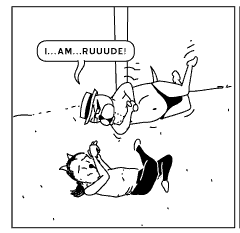
Ray made good use of this bonus in the Great Outdoor Fight.
Ray's big fat ass also has 43 hit points, and he has a respectable action ranking of 3. He also has a good Luck stat, even if his reasoning roll isn't going to drop anyone dead. What is more, as a Kzin, he gets two attacks with his claws on the same impulse if he's fighting barehanded, doing 1D8+2 for each that hits. If he hits with both, he also automatically grapples for a free 1D8+2 every impulse that he keeps his claws in that opponent, and can also attempt to bite for 1D6 damage to a location of his choice on his next turn. (It is unclear if Ray's monster damage bonus applies to these attacks as well.)
That's not all: He can also parry attacks with his giant cat arms, including most melee weapons that don't involve energy blasts or variable-sword monowire. (Parrying a variable-sword with your arm is a great way to lose your arm.) If Ray does get his ass kicked, he can make a health roll (CONx3) to remain conscious, although he would take double injury from blood loss if he did. But it might be clutch.
Some of the details here aren't clear, but the long and the short of it is that Ray is going to beat just about anyone short of a protector in a bare-ass gladiator fight. It is not even clear if he has to roll at all to hit them with his claws, or if they would just get the option to make Dodge rolls to not get hit.
I'm not doing his skill block because that would be intricate, but the breakdown is like this:
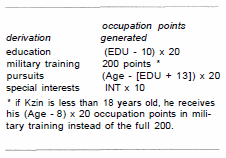
go to cat school or end up in cat jail
Ray would get to break down his 200 points from being in the Patriarchy military among a range of classic fighting skills, though he would obviously heavily favor Unarmed Combat. He would be limited to 1D3 skills, probably related to music production and promotion, from the human occupation list, representing the narrow focus of his professional training.
The Kzinti pursuit list is much narrower than the Human one. Ray would be an Explorer, which means he would be working for the Patriarchy even if he was part of a Human expedition. Other options include criminals (on the lam, against the Patriarchy), prisoners (from human space - the Kzin execute criminals who humanity would imprison), soldiers, functionaries, pilots and zealots.
The Kzin have a Defects list as well.
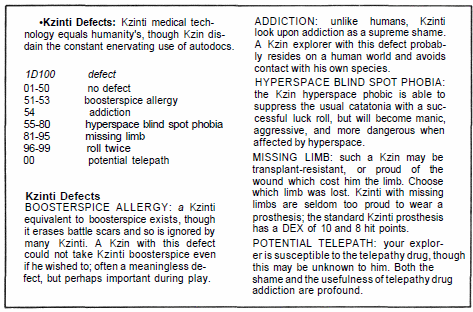
Ray has no defects, although his fellow from the Great Outdoor Fight is a potential telepath.
Anyway, this makes clear part of why Kzin are gated away from the primary explorer generation: A Kzin party member will dominate many physical encounters, which is accurate to the fiction but may be annoying if everyone isn't on board. They also suffer few fundamental debilities, although they may lack the skill base of an elderly human. The Kzinti boosterspice equivalent is newer than the human version, and as said above, is often disdained because it takes away your sick cat scars.
Most Kzin would also likely be working for the Patriarchy; even a prisoner might be able to win back his honor and get a Name if he booked it for Kzin with some new superweapon. This can, of course, be fun.
Next time, the Puppeteers!
death on three legs
Original SA post death on three legs
Today's topic of discourse are the most civilized people in Known Space, or rather, WERE the most civilized people in Known Space - MY people - the creatures known to Earth as Puppeteers. As with the Kzin, we'll start with the setting details.
First, anatomy and physiology. Puppeteers are highly intelligent, non-humanoid herbivores who formed large herds. They are tripedal, with two "heads" that combine eyes and "hands" (in the form of mouths). They are legendarily cautious and conservative, although their civilization arose during the Pleistocene on Earth, so their cautious and careful advancement has left them far and away the most advanced entities in Known Space, technologically speaking. Other than the Outsiders, of course, and perhaps whoever built the Ringworld.
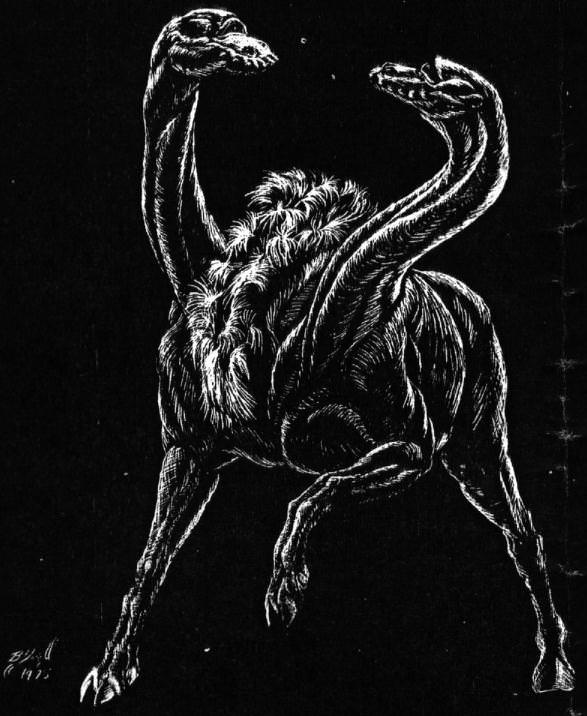
a portrait of your correspondent, who is anatomically typical of a puppeteer. less insane puppeteers are typically better groomed and have mane ornaments.
You may wonder what is up with their name. The first human to see a Puppeteer was struck by the similarities of their heads and necks to sock puppet creatures. (Indeed, specifically to Cecil the Sea-Sick Sea Serpent from a camp retro revival of Beany and Cecil.)
Anyway, Puppeteer mouths are also able to serve as very agile hands - fine-control equipment made for Puppeteers requires tweezers or careful claw-tip usage (for humans and kzin) to operate. They are excellent vocal mimics and can speak alien languages fluently. Their voices, in human terms, typically resemble sultry female contraltos, although the emotional nuance tends to weaken or vanish entirely if the Puppeteer is under emotional stress. The Puppeteer sexual reproduction cycle is not well known in Known Space, although there are speculations; the truth of the matter is that there are, depending on how you look at it, three sexes or two sexes who are obligatory parasites on a third. Puppeteers don't discuss the matter with aliens, and in fact consider humans to be sex-obsessed.
Puppeteers have extremely long, probably unbounded lifespans as individual organisms. (The Puppeteer home worlds, which are bound to a star that they are able to control, contain over a trillion Puppeteers.) They believe that their science has proven that there is, at least for their species, no immortal part or soul. This reinforces their extreme caution as a species, which comes off as cautious. Every Puppeteer that a human has ever met is congenitally mentally ill - not just in the sense of being judged by their culture, but in the sense of suffering from observable mental disorders. No sane Puppeteer would ever risk meeting an alien. Too dangerous. Or going into hyperspace. Too dangerous. Et cetera.
Puppeteers, despite this defining cowardice, are practical, methodical, industrious, unsentimental, and will - when forced by circumstances - act ambitiously and daringly. They are also amoral (by human standards, anyway) and can be remarkably, horrifyingly ruthless (to humans - though the Kzin understand THAT better.)
The main engagement of Puppeteers with humanity (and indirectly the Kzin) was General Products, a conglomerate of industrial firms that produced extremely high quality goods in a huge range of fields at reasonable prices. Notably, this included nigh-indestructible starship hulls. (How nigh-indestructible? It is illegal to sell them to the Kzinti.) They were straight dealers and at its peak, General Products employed (directly or indirectly) nearly two billion humans. There was a profound interstellar depression when the Puppeteers closed up shop to fuck off, several tens of thousands of years in advance of a radiation wave coming from a chain-explosion in the Galactic core. Their interest in the Ringworld is, in part, its potential as an even safer habitat for themselves.
Anyway, character generation for Puppeteers begins with a note that the GM may wish to restrict them, or limit the number present.
Name: Puppeteers typically have aliases for talking to humans. Their actual names are in their language, which they don't share.
Gender: Irrelevant; the two Puppeteer characters of note in the Ringworld books were referred to as male, but this was a courtesy or Louis Wu's terror of a non-binary organism.
Homeworld: All Puppeteers are from the Puppeteer Fleet of Worlds. They don't breed elsewhere.
"Mad Puppeteer": You are encouraged to pick out 1D3 distinctive character traits (which, I suppose, was remarkable at the time) to emphasize your Puppeteer character's personality disorder. Examples include humorous, optimistic, mystical, hypochondrial, careless, curious, etc. It is noted that even a "careless" or "happy go lucky" Puppeteer will still appear colossally cautious by Human standards.
Chronological age: There's a table. The maximum possible age for a Puppeteer is 159; it is noted that older puppeteers, even if they are mentally disordered, tend to either die somehow or level out as they cruise past their second or third century. Physiologically, Puppeteers are 30 years old, because that's when they start getting longevity injections from PuppeteerCare.
Education: Every Puppeteer goes to school for at least twenty-five years. Rough.
Characteristics: Puppeteers get the same stat rolls as Humans, and have comparable general body volumes, if obviously on a very different anatomical frame. Their INT roll is 2D6+15, and their POW roll is 3D6, presumably to represent a generally weaker will.
Hit locations: As creatures who can lose a head and still survive fine, they have different hit locations.
Mental disorders. As stated, Puppeteers who are willing to go on an expedition are nuttier than squirrel turds, to the point of having objective, organic disorders -- at least, by Puppeteer standards. Here is the table:
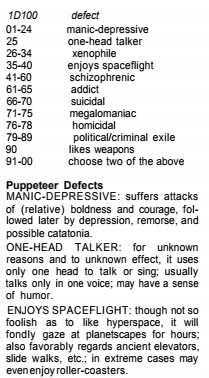
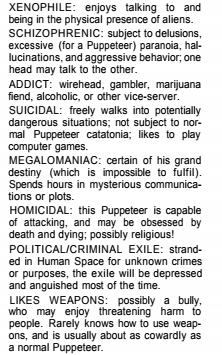
don't tell TFR about result #90
Puppeteers get action rankings as per humans. A puppeteer's base movement is 5 meters per impulse, and they can haul ass at 10 meters per impulse. Leaving aside the occupation/skill points system, they get a few more bells and whistles.
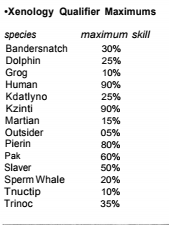
in a tragic twist of fate, the first Puppeteer to address a sperm whale had chosen "Ahab" as a nom de xeno. they got off on a bad hoof, but fortunately for them, sperm whales went extinct in the 20th century in known space. suck it, whales!
Despite their cowardice, Puppeteers who are pressed have a natural attack with a to-hit chance of DEXx4 in which they sight in with their two heads and deliver a bejesus of a kick with their hind hoof for 2D6+2 damage. In at least one attested case, this administered non-trivial injury to a Kzin officer. Puppeteers can also watch two different target arcs - their heads can track independently. Finally, if confronted with obviously superior odds, a Puppeteer will curl up into a ball and become catatonic, and thus no use to their comrades. Charming.
This actually ends the Explorer book, other than a glossary of Known Space terms, some of which are painfully obvious but may have been much less so in 1984. Also, some terms have important details - for instance, the Pierin can see in infrared.
Shall we explore the Technology book next, or shuffle over to Creatures, which will give us more details on the Ringworld itself, albeit indirectly? We could also dip into the more physical details of the Ringworld as well as its history, as best as is recorded by Ringworld hominids, if people have a mind. Vote! Ask questions! Express yourself, before the ARM comes and collects your brains!
Pak
Original SA post https://www.youtube.com/watch?v=0-MONIvP6kI
By popular demand, we are going straight to the section on the Pak in the Creatures book. After this we'll go through the Creatures book proper. If our archivist wants to rearrange this and omit this paragraph, go nuts.
The Pak are native to a world with a higher baseline radiation rate than the loving shores of Earth, because that planet is nearer to the Galactic core. (Alert students may ask, wasn't the Galactic core exploding? Yes it is. Did the Pak do it? Unknown, but let's be honest: Probably.) The Pak are, to quote the book: "Extremely intelligent, strong, and warlike xenophobes." Their life cycle has three stages, which we discussed but we'll hit again:
CHILDHOOD: Self explanatory.
BREEDER: Sub-intelligent bipedal primates. In the original novel, they were presented as explicitly Homo habilis, which was less implausible than it was in 1984, given the knowledge of the time, and how much of it had worked its way to Larry Niven. (A character in "Protector" objects to this theory and is not well rebutted.) This book walks this back by saying that Pak breeders resemble Homo habilis; basic tool use is within their grasp, but their brains are limited. As the name suggests, these folks mostly produce babies and perhaps provide some basic care.
PROTECTOR: Around age 42 (UN standard years), a breeder who didn't die somehow becomes sensitive to the aroma of a common hardy perennial bush, whose roots become alluringly delicious. The breeder, inevitably, chows down, and is exposed to a symbiotic virus that produces CHANGE.

a flattering portrayal of a protector
The skull grows and the brain gets bigger than a human's. The hair falls away. The gums and lips fuse together into a durable "beak." Hair drops off. Gonads and genitals are resorbed. The joints swell, giving a protector "increased moment-arm" or whatever, but which I choose to parse as the same phenomenon that makes a gorilla able to murder you without trying hard. The skin gets thick enough to be light armor. Fingernails become like claws. The back petrifies into a durable hunch. A backup heart develops where the junk used to be.
A newborn protector awakens and (in the case of Pak) figure out a lot of shit really fast. Pak protectors are smart as hell. Yet they are bound by a burned-in motivator to protect their relations, who they recognize both by the obvious expedient of looking at them and remembering who they are AND by their "smell." Any other Pak breeders are the enemy, although it seems as if temporary cooperation is possible. Pak protectors build nuclear, chemical and biological weapons; their secrets are lost in their use or counter-use, or neighboring protectors attacking; temporary alliances form to rehabilitate areas devastated thus; they collapse when the areas become viable breeder habitat.
The Pak try to colonize other worlds. It usually falls apart because the colonies get continually invaded by Pak ships from later waves, who want this land for themselves. They do not deal with aliens save to study their weaponry.
"A protector's intelligence is certainly high; but intelligence is merely a tool to be used to reach a goal -- and goals are not always chosen intelligently."
Protectors can be chill, if their breeders are fine for the moment. They lapse into a drowsy state and dream. If their bloodlines are extinguished, this state can become permanent and they starve to death. There are protectors who manage to convince themselves that some great project makes it worth continuing to eat, as ultimately they're all Pak. There's a Library of knowledge, in a desert seeded with radioactive cobalt (protectors don't care), where childless protectors may go and study or help with the library itself.
Why do we care about these guys? Some of them had the idea of moving WELL away from Pak - indeed, one of their earlier interstellar flights. A vast colony ship! The trip was long enough that protectors died of old age, which was medically remarkable enough that they sent detailed accounts back to the Pak Library by message laser. By the time they got to the third planet of a yellow star, there were thirty protectors left. They turned loose the breeders, mostly in Africa but with some in Asia and Australia. They zapped some of the menacing creatures and went out to build some industrial infrastructure. Everything was coming up roses, and there was no fighting among the protectors. What was to fight about? There was an entire world out there. Room enough for all, at least for a long while.
A year later it turned out that for whatever eccentric reason, Tree-of-life didn't grow right in Earth's soil. It was edible, it grew, but the virus didn't carry over. The surviving protectors thought, well, maybe it's the lack of starlight, but their experiences bore no fruit, and they were now on a hard limit - their remaining root stock was a hard cap on protector work-years remaining. They built a message laser to beg Pak for help for the breeders, strewed around some radioactives and did some bioengineering so the breeders better suited Earth's ecological systems, and died out.
That was Earth, 2.5 million years ago. The Pak breeders evolved to become us and all the other species of genus Homo; it is suggested that some of them became Devo and also became gorillas, chimps, orangutans, etc. It is also suggested that many aspects of human religion (this is one of the weaker ones) are furtive half-abbreviated yearnings to become protectors, as are the specific symptoms of old age.
The problem, it turned out, was a thallium oxide, and the guy who ran into Jack Brennan was coming in with a big supply of that chemical along with some notes. This protector thought he was a great and selfless hero. Jack Brennan killed him before he could realize exactly how badly humanity had diverged from the Pak baseline.
Anyway, the scent of tree-of-life root attracts humans, although it is possible for humans in turn to resist. It takes immense willpower; recovered drug addicts appear to do the best at it. If you're too old, you die in the transformation. You may die anyway. (It's unclear if many Pak protectors also die in the transformation. Wouldn't surprise me.) Human protectors are smarter (if somewhat weaker) than Pak protectors, and have significantly more mental flexibility, as well as retaining things like humor, artistic desires, et cetera. They have empathy, which Pak do not have. They can also get bored. Every human protector's first post-transformation thought is something along the lines of: "I've been INCREDIBLY stupid..."
Humans also have a genetic flaw in their protector programming, so to speak: They don't give up, sit down, and let themselves starve to death nearly as easily. This is arguably a feature, not a bug, but not if you ask a Pak. Human protectors are not good guys; they are entirely willing to do things like sacrifice entire colony worlds or make major adjustments to humanity in general. However, most of them are also focused on figuring out how to fuck with the Pak, who are, after all, probably fleeing the Core explosion - and heading towards a nice, safe, distant colony world whose only problem was a lack of soil minerals...
We're not done here, but this is getting long. Next up, the plot of the novel "Protector" and a discussion of the actions of the Pak with regards to the Ringworld. I'll give you a hint: Guess why we've consistently heard about "Ringworld hominids?"
drivin' me crazy, i'm goin out of my mind
Original SA post drivin' me crazy, i'm goin out of my mind
We resume our examination of the Protectors.
The childless protector Pssthpok (the Pak language isn't very much like ours) reasoned out how to fly to Earth in order to provide us with a bunch of thallium oxide and fresh supplies of Tree-of-life. (Pssthpok had also discovered the virus in Tree-of-life root, which had previously been unknown to the Pak.) Jack Brennan got changed by exposure to Tree-of-life, did not speak much to Pssthpok, and then brutally murdered him. (Pssthpok was previously male. Protectors seem to identify as their breeder-stage gender. Fun trivia.)
Anyway, Brennan geared things up and helped Earth along. He went to the Home colony and exposed the descendant of his who had come along for the ride to an infectious version of the tree-of-life virus, which swept through Home and converted those in the right age bracket into protectors while killing everyone else. This new batch of human protectors went off to engage the outside scout waves of a Pak exodus fleet. Their long term fate is unknown but the Pak have not yet reached Earth. Home was resettled in the late 26th century.
The remains of Pssthpok are on display at the Smithsonian. This was considered a trivial point of academic interest, based on both the facts of Pssthpok's body and Jack Brennan recording a summary of the facts as he understood them for the sake of humanity before he vanished forever. Whether due to popular sheepleness or suppression by the ARM, it was considered a curiosity until the discovery of the Ringworld.
So why do you care? Well, the hominid species of the Ringworld are also descended from the Pak. There is a canon answer for all of this, which the RPG book ignores, saying in a carefully speculative way that the Ringworld might have been built by Pak protectors who came after Pssthpok and set out to make their own damn megastructure and conceal it from other Pak until they were in an unfuckable level of development. (The Ringworld has mighty defenses. We'll get to them later.)
The Pak who built the Ringworld - if indeed they did - gathered a bunch of other entities. It is theorized that some of the disappearing varieties of hominid on Earth may have been because the Pak landed and collected them all to turn loose on the Ringworld. They also created "Maps" - artificial terrariums which were approximately the same size as various alien worlds, which were then populated by samples from those alien worlds, including most of the aliens of Known Space, though not the Puppeteers. The Outsiders were also spared... but they wouldn't have been suited for the Ringworld anyway.
Anyway, the protectors died somehow. Reason unknown. Sometimes people on the Ringworld still get hold of some tree-of-life and protector up, but it's rare and occasional. The breeders, now left to themselves, diversified across three million or so Earths' worth of land mass, specifically made to be pretty comfortable for them. The population of the Ringworld is estimated at thirty trillion intelligent beings - almost all hominids, if with a planet's worth each of kzin, trinocs, kdatlyno, pierin, martians (now the only surviving ones, since Brennan killed the ones on Mars) and, potentially, others as well.
Ringworld hominids have significantly less hypothetical memory of protectors, even if the folk image of these beings resemble eccentric wizards or gods. Many low-tech hominids pattern their armor after protectors. The details of a protector from a hominid species will vary wildly.
We get more speculation - the hypotheticals here are because the GM section, in large part, suggests that you, the Gamemaster, determine certain core mysteries for yourself, which can explicitly include things like "the Pak found the Ringworld, they didn't build it."
Now, what you've all been waiting for: THE PROTECTOR STAT BLOCK.
To become a Protector, be a human at least thirty years old, find some Tree-of-life root, and mash it into your face hole. Make a luck roll. If you fail, you die! If you succeed, in 1D4+3 days, you awaken as a protector. (Oh, and protectors are not suitable for PCs, or so the rules say - turn over your character sheet.)
Stat adjustments:
STR is doubled, then add 6 more.
CON is doubled.
Add 5D6 to INT.
POW unchanged.
DEX is increased by fifty percent, rounding up any fractions.
APP is lowered to 6 because you look like some kind of a bird monster and lost all your hair.
EDU is unchanged. Open enrollment starts January, ya freak.
MAS increases by 6.
Protectors lose the human maximum for the Scent skill. Skills the protector knew as a hewmon increase by 1% per 10 days for 500 days, and at 2% per 100 days thereafter, until 5000 days have passed. This is meant to represent how you kind of chew over all your old memories and figure out what you fucked up.
Research and training take a third of the time they would for a human. Protectors also gain a natural armor of 5.
I think that it is appropriate to the fiction that protectors would not be available for play by PCs, partly because they can break the impulse system over their bony knees but also because even one of the ones who breaks himself or herself from the impulse to protect their descendants is still going to be a villainous superintelligence. However, they do make great antagonists, and are not so transhumanically intelligent that they cannot be reasonably played by a GM, given time to think.
Next time on Ringworld, we'll be exploring the intelligent beings of Known Space. While I can't guarantee we'll get through all of them in one post, the Bandersnatchi, Dolphins, Grogs, Kdatlyno, Outsiders and Trinocs are all up next. After that we'll run through types of hominid presented in the fiction - which are really more broad ecological niches, plus a couple of very successful species, than a species-by-species guide. Get hype!
And now for something completely different.
Original SA post And now for something completely different.
We resume the Creatures book with ALIENS! Ones that, by and large, do not even have hands.
First up are Bandersnatchi.
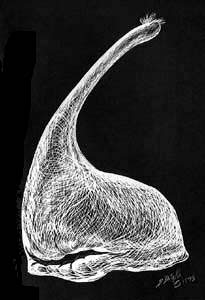
what handsome fellows. also this guy is bigger than a tank
These massive creatures live as filter feeders in swamps on Jinx, and have been found in other habitats. They are technically massive single cell organisms, that single cell weighing over thirty tons. They were made as food animals by the Slavers and do not mutate, so they've been puttering around with oral cultures ever since then. They fully understand humans - the ones on Jinx get 80% of the proceeds from consensual tank-based hunts which the Bandersnatch win the majority of the time. They also work in the high-pressure areas of Jinx, using prosthetic manipulators bought from humans.
Bandersnatchi exist on the Ringworld - there's a "Map" of Jinx, and some seem to have gotten loose in the past.
They are of human-equivalent intelligence, but are the size of apatosaurus, so they are not really good explorer characters. Their special attack is to worgle over you and crush you beneath their massive frames.
Next up: Dolphins!
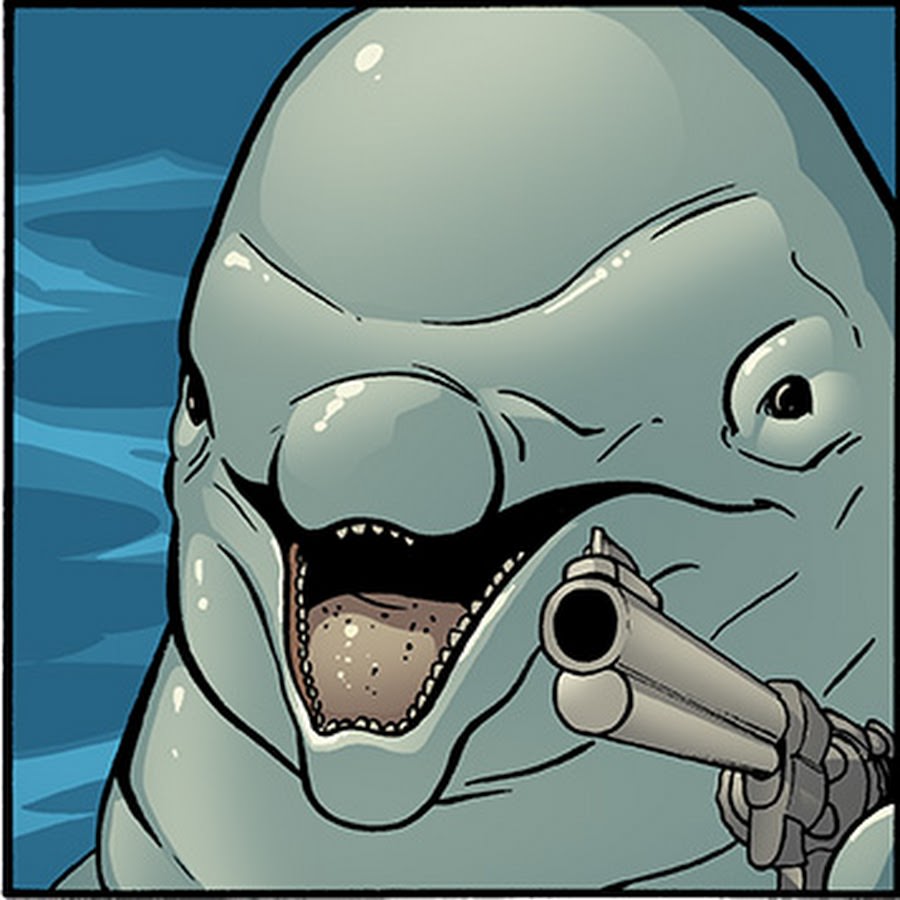
look out!
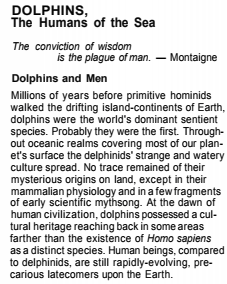
Yeah, it was the 1980s.
There is an entire page about how humans used to be really friendly with Dolphins, but then "the Man" got in the way and advanced an anti-dolphin agenda as wlel as encouraging people to eat dolphins and so on. The guy from "Day of the Dolphin" made a breakthrough in communication, and the UN banned all whaling in 2017 as well as extending legal protection to dolphins. Dolphins immediately sued Humanity for damages; the lawsuits have not concluded yet, and it is thought that the dolphins are, at this point, taking the piss.
You can learn more about how dolphins work from Wikipedia. Humans sold them prosthetics much as they did to the Bandersnatch, and later, also "aquasuits" - powered armor, essentially, letting dolphins come up on land. Friendship with dolphins revolutionized oceanography and aquaculture, which is probably part of why Earth can support 18 billion flatlanders. Dolphin Studies is a major in college. It is difficult for dolphins to speak easily with humans, but they give things a try. Dolphins are also present on most human colony words with quality ocean space. There are between 8 to 10 billion dolphins in Known Space, and most spaceports have at least basic dolphin accessibility.
Dolphins can be explorers but have obvious problems if you aren't based in water, which is why they aren't in the core book. They are basically the same as humans save for being bigger and stronger, if less so than Kzin. They also do not have boosterspice. But they're good at piloting!
Then! Grogs!
The only intelligent form of a Grog is a large sessile organism who feeds by using their powerful psionic domination abilities to tell food to come get eaten. (Other life stages of Grogs are much more mobile.) They contacted Humans on Down through the firm that produces hands for dolphins and bandersnatchi. Grogs can get around on automatic mobility chairs.
Grogs are mostly found on Down, although the "Map" of Down also hosts them on the Ringworld. A Kzinti exploratory party tried to reach that Map and was never heard from again. Probable outcome: Dinner.
And furthermore: Kdatlyno!
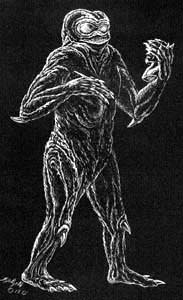
what's up
Kdatlyno are 3-4 meters tall, blind as bats, use ultrasonic signals and sensitive touch to perceive reality, and are fugly as hell. They have a sort of natural X-ray vision and are famous for touch-sculptures. They managed, despite being blind, to get into space, and sent out helpful signals on the 21-cm interstellar hydrogen band to try and contact friendly aliens.
Instead, they got the Kzin. The war was brutal, brutal enough that the Kzin gained a purported respect for the Kdatlyno, which seems to mostly mean that they were used as labor slaves rather than meat animals. They were liberated in the second Man-Kzin war. They are renowned for vengeance plots, and it is speculated that they are, on a species-wide level, planning some horrifying, Monte-Cristo-esque revenge upon the Kzin - but as far as anyone can tell, why, they're just folks, and they trade happily with the Kzin. No hard feelings, right?
Kdatlyno are bigger than humans but otherwise comparable, statistically, other than having 4 points of natural armor and being stone blind, even if their Daredevil senses can make up for it. They often need special equipment, but when they have that equipment, they're as able as humans.
Next time: Trinocs, Outsiders, and the City Builders.
more creatures
Original SA postNow that the festivity bird has been eaten and I've levelled Astrologian for a while, it's time to return to

The Creatures book briefly gives you the capsule stat block for a Kzin or a Puppeteer but refers you to the Explorers book for more deets.
Then we get the Outsiders, which is where things become, briefly, truly bananas.
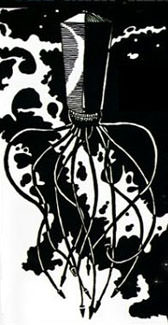
no, no - you're not a virus, trust us. we're much closer
The Outsiders are beings with liquid helium for blood, or its blood equivalent. They live in the space between stars, by necessity. They seem to gain energy by having part of their bodies in shadow and other parts in starlight. They are not just cold, but fragile: an Outsider in lunar gravity would probably die within an hour. They travel, pursuing mysterious "starseeds" through relativistic space, watching things and taking their time. They seem to get along with most people, perhaps because they are so intensely alien that they pose no threat or rivalry. The one valuable thing they seem to have is information.
Rather than lurking in a shady bar and selling you plot coupons through their mustaches, the Outsiders in large part swap technology and, occasionally, services (ferrying the stranded and so on). You get credit from them by telling them things. You spend that credit to get important information, though in peaceful areas they may also lease remote iceballs - they lease Nereid, the moon of Neptune, from the United Nations in Known Space.
As discussed elsewhere, humanity bought the hyperdrive from them. The Puppeteers bought a reactionless drive from the Outsiders long ago and are still paying in installments. The way that the Outsiders work on their slower-than-light sojourn is that they get in touch with intelligent life forms as they pass through the areas of space they control... do their deals... and move along. Presumably they got the hyperdrive - and the Puppeteer reactionless drive - from somebody else, or put it together from other technologies they traded for. (Individual Outsider lifespans are ballparked at a million years.) The Outsiders are de-centralized; they have common habits, but they don't all keep in touch.
There are no Outsiders on Ringworld... as far as is known. It is technically possible for an Outsider to visit, in a gravity-suppressed vacuum capsule... and they would, of course, have no issues with the OUTSIDE of the Ring.
Statistically speaking the Outsiders are very frail and weak, although they have a relatively generous Appearance statistic for a weird cryonic space squid (3D6, average 10-11). They also do not have a record of weapons.
The Trinocs.
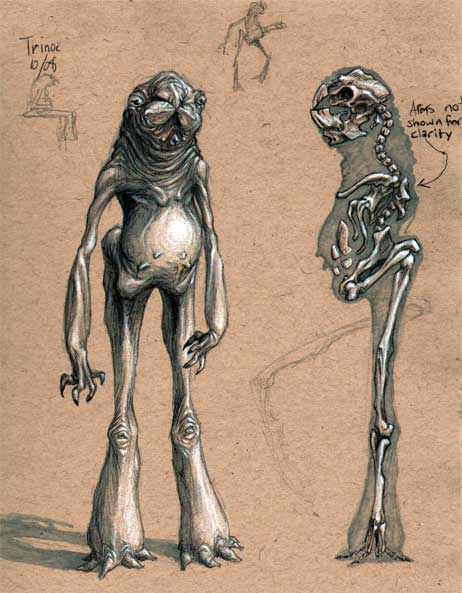
The Trinocs are weird looking guys who largely live on the "other side" of Known Space. They were only recently met by Humans (indeed, Louis Wu ran into them - if you want to talk about author-insert characters...) although the Kzin knew of them. The Trinocs were able to fend off our big ol' tabby cat friends, and the Kzin may not have had much interest in them compared to humans or Pierin - Trinocs, you see, are methane-breathers, as well as having a complicated internal metabolism and biochemical structure that - well - I'm going to just quote from the rulebook here.
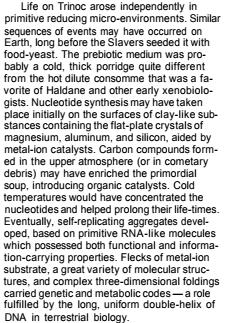
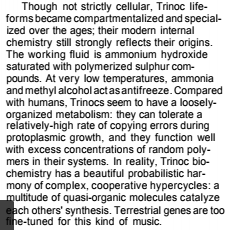
"so what you're saying is that they're not good eatin'."
As is typically the case, the United Nations has cut a deal with the Trinocs, who have a small outpost on Titan. Earth has agreed to respect Trinoc space and avoid terraforming Trinoc-friendly worlds. In Earth-like environments, Trinocs need breathing suits or special facilities. Their weapons are very good, probably in no small part due to their adjacency to the Kzin.
Trinocs are not statistically treated as very different from Humans and lack special powers, beyond a different hit location table. They don't even have innate armor, although the environmental suit a Trinoc will probably be clopping around in if it comes to the Ringworld may well.
We're going to call a halt here because from here on out it's all zany Ringworld hominids. We'll begin with the City Builders, who may take up an entire update. They were truly forward thinking individuals, who changed the face of the Great Arch!
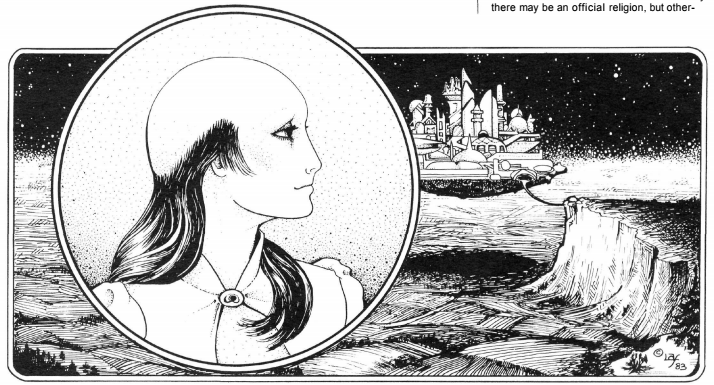
our founder, john q. rishathra
City Builders
Original SA post On the Nth day of Christmas, my true love gave to me,Nine Outsiders trading
Eight dolphins dolphing
Seven kzinti leapin'
Six organs legging
FIVE GOLDEN

We return with discussion of the City Builders.
This hominid race built cities, as one might expect; more notable is that they built cities that floated in the air. Their culture, or something recognizable as their culture, spread across half the surface of the Ring, despite individual centers of City Builder civilization occasionally being as far from one another as the Earth is from the Moon. They cooperated with dozens of other hominids, and built great works as well as spreading and mingling culture in their great cities. Images of City Builders are cognate with images of gods or angelic beings for many hominids, and it is possible that the City Builders reached the worlds of Known Space, because - somewhat short-sightedly - they jury-rigged the Ringworld's attitude jets into motors for interstellar spacecraft.
In addition to greatly facilitating the intermingling of cultures and probably being imperialistic bastards even if the raw, staggering scope of the Ringworld meant that it would be hard for almost any boot to rest hard, the City Builders caused problems. An obvious one is that they scavenged the attitude jets of their entire megastructural habitat for spaceships. (In their defense, the Ringworld presents challenges to technological civilization... and the City Builders couldn't meet the Outsiders.) They deliberately spread "vampires," a hominid species using pheromones to lure and prey on other hominids - they extracted those pheromones, in part for their other "invention," the formal conducting of sex between different hominid species, for whatever purpose. While this practice probably was not invented by the City Builders, they sure as hell formalized "rishathra" and spread it across their empire.
You will notice the use of the past tense for the City Builders. While the City Builders are not extinct, an event known as "the Fall of Cities" spread throughout the Ringworld about 1200 years prior to the present day of the setting. (So around 1750 AD.) This caused a breakdown in their magnetic levitation technology, leading to - well - the fall of cities. At a stroke nearly all their works were set to naught, although there may still be City Builder ships or colonies well out there on some unknown planet.
One might, at this point, fairly ask: Okay, but why does this matter? The answer is that City Builder ruins are huge and widespread across the Ringworld, and bear vast quantities of various forms of wealth - technological secrets! Unique alien art! Wonders beyond understanding! Things that made 29th century humans befoul themselves in astonishment! In other words, they are adventure hooks.


too soon.

The City Builder species is not extinct, although they have not made efforts to restore their cities beyond landscaping the ruins in areas where they have remained. (It is possible that attempts were made in the past, and failed.) Survivors often have access to automatic and electromagnetic weapon that was not destroyed in the Fall of the Cities, and are not eager to share. For that matter, the wreckage of the cities can hold all sorts of weird-ass Stalker-esque technological oddities; a mere sample is the cziltang brone, a device the City Builders used to "soften" matter so that other objects could slide through it. Imagine one that's poorly calibrated and just... running. Somewhere. In the ruins.
City Builders can be played if you want. A City Builder joined the crew in the first Ringworld novel; her name, Halrloprillalar, is apparently a typical example of the species. City Builders are similar statistically to humans but have a 4D6 POW roll (probably how they kept going so long) and 3D6+9 DEX, perhaps because they have realized the underlying physical substrate of mechanical action. They can know any skill, with the exception of Hyperdrive Pilot: they had access to an immortality drug, comparable to (if incompatible with!) boosterspice, and they had it for much longer.
They are also very smug and probably had the superconductor plague coming to them.
Did we not mention this? Well, in the GM's section, you get the whole story - at least according to this version of events. (Later Niven novels may have changed things around.) Around the same time that the colony of Georgia was founded on the eastern seaboard of the United States, the Puppeteers - who had bought the location of the Ringworld off the Outsiders - deposited a technologically voracious bacteria throughout the Ringworld that fed on a superconducting material that was key to City Builder infrastructure. The plan was to send in trading ships to scavenge up in the aftermath and, perhaps, take on the "role" that the City Builders had held, but political shifts on the Fleet of Worlds prevented that from actually happening, and the Puppeteers remembered the Ringworld in the aftermath of other events. Probably.
This plague caused vast ecological upsets throughout the Ringworld, because it fed on infrastructural elements predating the City Builders as well as the infrastructure they themselves built. The City Builder survivors theorize some kind of alien attack or a microbe that they brought back from another world. It is unknown if the bacterium still exists on the Ringworld; it feeds on only one of the four kinds of superconductors humanity knows about... but it may have mutated. Visitors are warned to be careful. Double-bag your gear.
Next time we'll ride through the remaining hominids, who, other than the Ghouls, are less lootable - in many ways they are adventure hooks in their own right. On the other hand, they have way more illustrations!
a war-scarred chieftain stares thoughtfully into the distance of the
Original SA post a war-scarred chieftain stares thoughtfully into the distance of the
We resume with an examination of the notable Ringworld hominids.
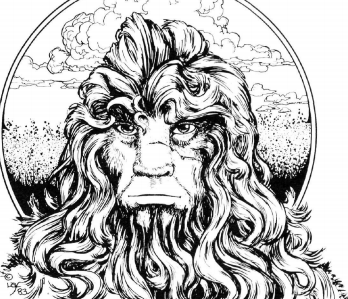
Grass Giants are large hominids who have spread into an ecological niche that was left wide open: that of the plains grazing herd herbivore. Each group has a king who is the biggest, baddest son of a bitch and is technically the husband of all the ladies. (There do not seem to be queens, but then the point seems to be that they live like plains buffalo.) Periodically the king wanders off for a while and whatever he didn't see, didn't happen.
The Grass Giants are the size of Kzinti, in some cases bigger. They are not complicated but receive prize of place because they were the first hominid species that the team met in the first Ringworld novel. One Grass Giant king challenged a Kzin to fight him for real without weapons, but the conflict was never resolved.
Grass Giant stats are more or less normal other than their huge size and a slightly lower average INT (2D6+5). Grass Giants have 2 points of armor from their thick skin, and typically have hardened-leather armor (2 points additional). Kings will usually have some kind of metal armor (6 points).
Hairy Ones are a catch-all for generic natives who were often affiliated with City Builders, but, well, we saw where that got them, probably. They're notable for having complicated religious or superstitious belief structures which were mostly developed to deal with how the City Builders' stuff all got dong-razzled due to the superconductor plague, and now all their "luxurious living" is "away from them." One classic example is a forbiddance of "fighting with light," which means your laser gun will not awe the natives, but will instead piss them off. O, Tempora! O, Mores! Statistically speaking, Hairy Ones are identical to humans, but stupider (INT is 2D6+4.)
Hanging People have returned to the honorable and traditional lifestyle of being an ape and living in trees. (This makes more sense given the mid-60s setting detail of the great apes probably also being the descendants of Pak breeders.) They are agile and dextrous and often find social niches with other species, serving as technicians or infiltrators into ruins... sometimes also thieves. They have also somehow managed to sprout prehensile tails... go figure that one out.
Hanging People take a hit for STR and MAS (both 2D6) as well as CON (2D6+2), but have an eye-popping DEX check of 3D6+12. Hanging People will thus probably break the action economy over their skinny primate knees, especially if
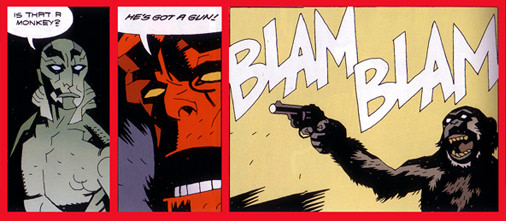
they acquire modern weaponry.
Herders are obligate carnivores who prefer their meat raw and who pursue their favored herd animal across the plains, coming in conflict with Grass Giants because their various animals eat the same food as Grass Giants. (Herders do not eat Grass Giants, not least because Herders are somewhat smaller than humans, and Grass Giants are the size of Kzin.) They are notable for being extremely friendly if you aren't in their way, and will happily talk to strangers. Their eagerness to chow down on some raw meat will also make them easy to get along with for Kzin.
Muck Ogres, or Mud People are a complicated case. The "Mud People" are actually tall, sleek and handsome folks who would be visually appealing to flatlanders. They tend to be insular and rude and mock outsiders, and are generally shunned by other hominids.
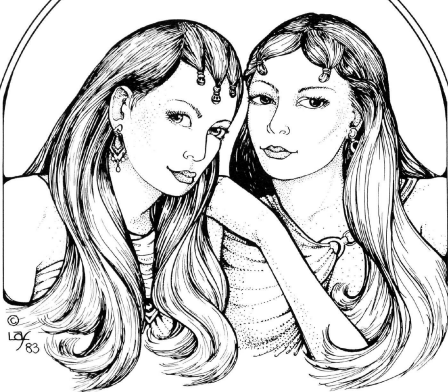
they are absolutely laughing at you
The Mud People also have a sort of curse. About two-thirds of their number, after reaching late middle age, will begin to mutate, slowly but surely...
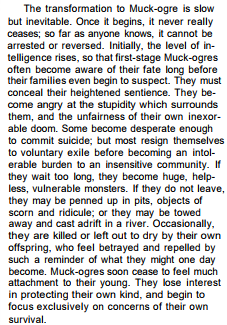
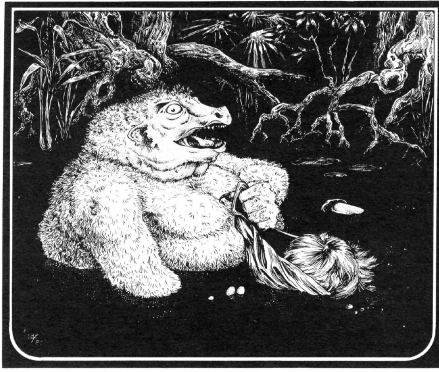
"much like my posting," eh? eh??
Part of why Mud People are relatively widespread on the Ring is that they were often kept by City Builders or other imperial cultures, who found Muck-ogres to be useful as living guards. Muck Ogres, while enormous and sedentary, are strong... and intelligent... and usually BORED. It is entirely possible to talk your way out of captivity, although courteous offers to study their genetic condition will usually not be a winning strategy.
That said, their condition IS genetic, and is clearly some kind of malformed expression of the whole protector thing, so it WOULD be worthy of study. If you're okay with doing that.
Next time, ghouls, vampires, and the healers!